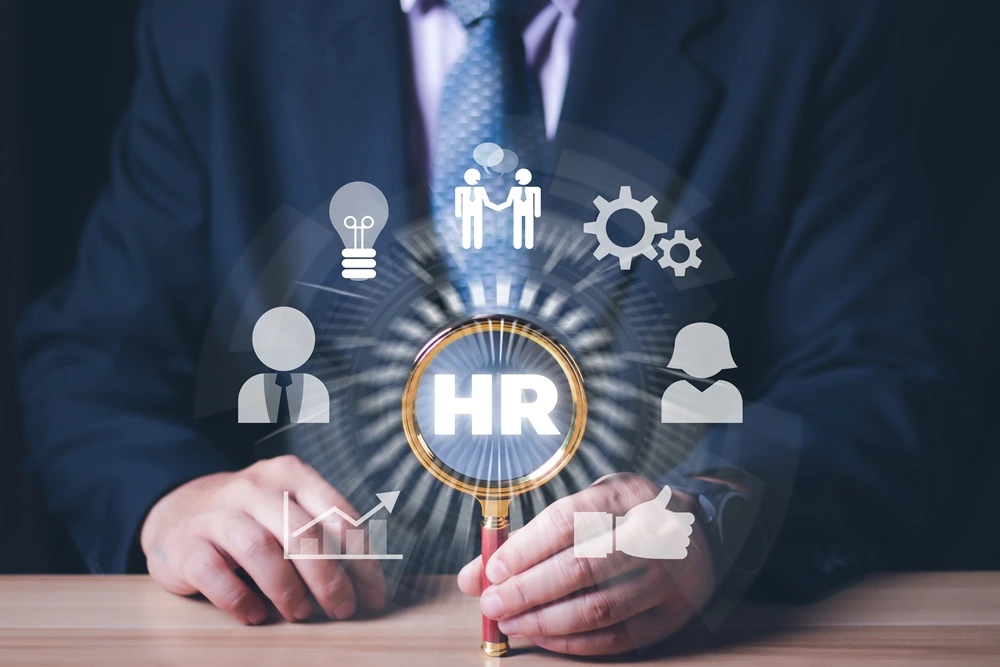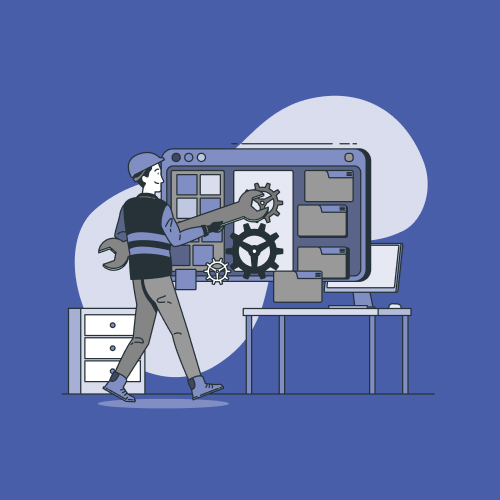HRMS software, or Human Resource Management System, automates payroll, talent management, and daily HR tasks. It serves as a central hub, consolidating employee records, benefits administration, and performance tracking into a single HRMS system.
Many teams face manual processes, disconnected spreadsheets, and evolving compliance risks when relying on legacy tools. Key benefits of HRMS software include:
- Time savings through automated workflows and approvals.
- Improved accuracy in payroll calculations and tax reporting.
- Employee empowerment via self-service portals.
- Strategic insights from centralised HR analytics.
MiHCM HRMS delivers a comprehensive suite that scales from small teams to global enterprises. Its modular design lets companies implement core HR and payroll first, then add talent acquisition or performance modules later. Built-in compliance updates and real-time dashboards keep teams agile and data driven.
As business needs evolve, the flexibility of a cloud-based HRMS system reduces IT overhead and accelerates updates. Modern HRMS software platforms leverage AI to recommend training paths and identify turnover risks before they impact engagement.
HRMS vs. HRIS vs. HCM: Understanding the differences

Choosing between an HRIS, HRMS system, or HCM suite depends on scope and growth plans.
- An HRIS focuses on core data storage and record-keeping.
- A HRMS system extends those capabilities with payroll, benefits, and time management.
- HCM platforms add recruitment, performance reviews, and learning modules to align workforce strategy with business goals.
Small and mid-sized organisations may start with an HRIS or entry-level HRMS software, then upgrade to a full HCM as needs expand.
MiHCM addresses each tier with modular licensing:
- MiHCM Lite: Essential employee records and simple payroll for up to 250 users.
- MiHCM Enterprise: Multi-currency payroll and global compliance.
- MiHCM Data & AI + SmartAssist: Predictive analytics and workflow automation for end-to-end HCM.
| Capability | HRIS | HRMS | HCM |
|---|---|---|---|
| Core Records | Yes | Yes | Yes |
| Payroll & Benefits | No | Yes | Yes |
| Time & Attendance | Limited | Yes | Yes |
| Recruiting & ATS | No | Optional | Yes |
| Performance & Learning | No | Optional | Yes |
| Analytics & AI | No | Basic | Advanced |
Use cases by company size:
- SMEs with limited HR staff: HRIS or MiHCM Lite.
- Mid-sized/large teams needing payroll and compliance: MiHCM Enterprise.
- Enterprises requiring talent optimisation: Full HCM suite with Data & AI.
MiHCM’s modular approach simplifies upgrades and keeps total cost of ownership predictable.
Core components and modules of an HRMS system
An HRMS software system organises every stage of the employee lifecycle into dedicated modules. Centralised data management and integration eliminate duplicate entries and ensure consistency across functions.
Key Module – Profile & Document Management:
- Comprehensive employee profiles: demographics, work history, emergency contacts.
- Document vault: contracts, certifications, performance notes in secure storage.
- Audit trail: version control and access logs for compliance tracking.
Key Module – Payroll & Compliance:
- Automated pay calculations: salary, allowances, deductions.
- Tax and statutory reporting: real-time updates for local labour law compliance.
- Pay slip distribution and audit-ready records.
Talent acquisition features include recruitment workflows and an Applicant Tracking System (ATS) to streamline hiring. Performance and learning modules cover goal setting, reviews, and training programs, fostering employee growth.
Time and attendance capabilities track clock-in/out, shift management, and leave requests via mobile app. Finally, analytics and reporting provide dashboards, custom reports, and KPI tracking, empowering HR leaders with actionable insights.
Essential features for 2025: AI, mobile, and real-time analytics

HR teams in 2025 require intelligent tools, mobile access, and live insights. The right HRMS software delivers all three through integrated AI, a mobile-first interface, and real-time dashboards.
- AI-powered recommendations for talent acquisition: automated candidate scoring and personalised learning paths.
- Conversational self-service via MiA: instant responses for leave balance, payslips, and policy FAQs.
- Mobile-first design: GPS/geofencing attendance, WFH approval workflows, and on-the-go task management.
- Real-time analytics from MiHCM Data & AI: visual dashboards for leave trends, performance metrics, and turnover hotspots.
- Secure biometric options: voice and facial recognition for clock-in/out and identity verification.
Feature highlights:
- SmartAssist automates routine approvals and escalations, reducing decision latency.
- MiHCM Data & AI unlocks predictive people analytics to anticipate retention risks.
Benefit summary:
- Faster decision-making with live data feeds and automated alerts.
- Higher employee engagement through intuitive mobile self-service.
Benefits and ROI of implementing an HRMS software
Implementing an HRMS software platform delivers measurable benefits across operations, finance, and talent. Companies often recoup their investment within the first year through streamlined processes and better workforce planning.
| Benefit | ROI Impact |
|---|---|
| Operational efficiency | Up to 40% reduction in routine task time |
| Tiết kiệm chi phí | 20% lower administrative overhead |
| Compliance assurance | Eliminates penalties with automated updates |
| Employee satisfaction | 30% higher engagement scores |
| Strategic impact | Data-driven workforce planning boosts retention |
Self-service portals reduce HR tickets by offloading routine queries and increasing transparency. Automated payroll cycles accelerate month-end close and free finance teams for analysis. Compliance modules with audit trails lower legal risk, while performance analytics guide development programmes.
Together, these gains translate into a solid ROI, making HRMS software a strategic asset for growth and agility.
How MiHCM addresses your HR needs with tailored solutions
Small Business HR with MiHCM Lite:
- Essential HR operations and basic payroll for teams up to 250 employees.
- Streamlined onboarding, profile management, and leave tracking.
- MiA conversational assistant for instant self-service queries.
- Rapid deployment with preconfigured templates to minimise setup time.
- Built-in compliance updates to handle local labour statutes automatically.
Enterprise-grade capabilities:
- MiHCM Enterprise delivers global payroll management across multi-currency, multi-jurisdiction environments.
- Employee lifecycle management from recruitment and performance to succession planning.
- SmartAssist automates approvals, onboarding checklists, and complex workflows.
- MiHCM Data & AI provides predictive analytics on turnover, absenteeism, and performance trends.
- Scalable modules let organisations add learning, benefits administration, and advanced reporting as needed.
With MiHCM’s modular design, businesses can start small and expand capabilities over time, ensuring a low initial investment and predictable total cost of ownership. These tailored solutions align with strategic goals while adapting to evolving workforce demands.
Deployment, integration, and security: What to consider
SaaS Deployment Advantages: A cloud HRMS software model offers automatic updates, faster feature releases, and elastic scalability. It eliminates infrastructure costs and simplifies maintenance, letting HR teams focus on strategy rather than system administration.
| Consideration | On-Premises | SaaS |
|---|---|---|
| Updates | Manual patches | Automatic, quarterly releases |
| Scalability | Limited by hardware | Elastic resources on demand |
| Upfront Cost | High capital expenditure | Predictable subscription fees |
| Maintenance | Dedicated IT required | Vendor-managed |
| Access | VPN or on-site | Global, anytime via web/mobile |
API-first integrations: MiHCM’s API framework connects seamlessly with ERP, finance, CRM, and third-party learning platforms. This ensures data consistency and reduces manual imports.
Data security & compliance: Encryption at rest and in transit, role-based access controls, and SOC 2 and GDPR certifications safeguard sensitive HR data. Disaster recovery plans and uptime SLAs deliver reliable operations.
Getting started with MiHCM HRMS: A step-by-step guide
Launching a new HRMS software platform requires clear objectives and a structured plan. Follow these steps to ensure a smooth rollout.
- Assess current HR processes and define key objectives aligned with business goals.
- Select appropriate MiHCM modules based on team size and functional needs.
- Plan data migration strategy: map fields, cleanse legacy records, and import employee data.
- Train HR staff and onboard employees.
- Go live, monitor adoption, and leverage SmartAssist for continuous workflow optimisation.
Future trends: AI and machine learning impact on HRMS
Emerging technologies are redefining the HRMS software landscape, making systems smarter and more proactive in managing talent and compliance.
- Predictive analytics for turnover risk: Machine learning models forecast attrition, enabling targeted retention efforts.
- Natural language processing in pulse surveys: Sentiment analysis uncovers employee mood and engagement drivers in real time.
- Automated compliance monitoring: AI-driven rule engines detect policy violations and flag potential labour law issues before audits.
- Hyper-personalised experiences: Employee portals adapt training recommendations, benefit suggestions, and career path insights to individual profiles.
- Blockchain integration for credential verification: Secure, tamper-proof record of certifications and background checks.
Adopting these trends allows organisations to shift from reactive HR administration to proactive talent management. Future-ready HRMS systems will embed AI throughout the employee lifecycle, offering built-in intelligence that scales with organisational complexity.



